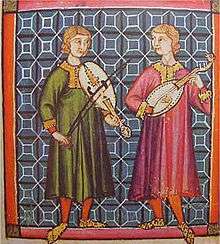Vihuela

The vihuela (Spanish pronunciation: [biˈwela]) is a guitar-shaped string instrument from 15th and 16th century Spain, Portugal and Italy, usually with five or six doubled strings.
History
 |
|
| Problems playing this file? See media help. | |


The vihuela, as it was known in Spanish, was called the viola de mà in Catalan, viola da mano in Italian and viola de mão in Portuguese. The two names are functionally synonymous and interchangeable. In its most developed form, the vihuela was a guitar-shaped instrument with six double-strings (paired courses) made of gut. Vihuelas were tuned identically to their contemporary Renaissance lute; 4ths and mid-3rd (44344, almost like a modern guitar tuning, with the exception of the third string, which was tuned a semitone lower).
Plucked vihuelas, being essentially flat-backed lutes, evolved in the mid-15th century, in the Kingdom of Aragón, located in north-eastern Iberia (Spain). In Spain, Portugal, and Italy the vihuela was in common use by the late 15th through to the late 16th centuries. In the second half of the 15th century some vihuela players began using a bow, leading to the development of the viol.
There were several different types of vihuela (or different playing methods at least):
- Vihuela de mano: 6 or 5 courses played with the fingers
- Vihuela de penola: played with a plectrum
- Vihuela de arco: played with a bow (ancestor of the viola da gamba)
Tunings for 6 course vihuela de mano (44344):
- G C F A D G
- C F B♭ D G C
The vihuela faded away, along with the complex polyphonic music that was its repertoire, in the late 16th century, along with the other primary instrument of the Spanish and Portuguese Renaissance, the cross-strung harp. The vihuela's descendants that are still played are the violas campaniças of Portugal. Much of the vihuela's place, role, and function was taken up by the subsequent Baroque guitar (also sometimes referred to as vihuela or bigüela). Today, the vihuela is in use primarily for the performance of early music, using modern replicas of historical instruments. Today, instruments like the tiple are descendants of vihuelas brought to America in the 16th century.
Construction
Vihuela bodies were lightly constructed from thin flat slabs or pieces of wood, bent or curved as required. This construction method distinguished them from some earlier types of string instruments whose bodies (if not the entire instrument including neck) were carved out from a solid single block of wood. The back and sides of common lutes were also made of pieces however, being multiple curved or bent staves joined and glued together to form a bowl, made from cypress with a spruce or cedar top.
Vihuela (and violas da gamba) were built in different sizes, large and small, a family of instruments. Duet music was published for vihuelas tuned one step, a minor third, a fourth, or a fifth apart, as well as unison tuned.
The physical appearance of vihuelas was varied and diverse; there was little standardization and no mass production. Overall and in general, vihuelas looked very similar to modern guitars. The first generation of vihuela, from the mid-15th century on, had sharp cuts to its waist, similar to that of a violin. A second generation of vihuela, beginning sometime around 1490, took on the now familiar smooth-curved figure-eight shaped body contours. The sharp waist-cut models continued to be built into the early-to-mid-16th century, side by side with the later pattern. Many early vihuelas had extremely long necks, while others had the shorter variety. Top decoration, the number, shape, and placement, of sound holes, ports, pierced rosettes, etc., also varied greatly. More than a few styles of peg-boxes were used as well.
Vihuelas were chromatically fretted in a manner similar to lutes, by means of movable, wrapped-around and tied-on gut frets. Vihuelas, however, usually had ten frets, whereas lutes had only seven. Unlike modern guitars, which often use steel and bronze strings, vihuelas were gut strung, and usually in paired courses. Gut strings produce a sonority far different from metal, generally described as softer and sweeter. A six course vihuela could be strung in either of two ways: with 12 strings in 6 pairs, or 11 strings in total if a single unpaired chanterelle is used on the first (or highest pitched) course. Unpaired chanterelles were common on all lutes, vihuelas, and (other) early guitars (both Renaissance guitars and Baroque guitars).
Repertoire

The first person to publish a collection of music for the vihuela was the Spanish composer Luis de Milán, with his volume titled Libro de música de vihuela de mano intitulado El maestro of 1536 dedicated to King John III of Portugal. The notational device used throughout this and other vihuela music books is a numeric tablature (otherwise called "lute tablature"), which is also the model from which modern "guitar tab" was fashioned. The music is easily performed on a modern guitar using either standard guitar tuning (44434), sometimes called "new lute tuning", or by retuning slightly to Classic lute and vihuela tuning (44344). The tablature system used in all these texts is the "Italian" tablature, wherein the stopped frets are indicated by numbers and the lowest line of the staff represents the highest-pitch course (or string), resembling the neck of the instrument in playing position; Milán's book also uses numbers to indicate the stopping of the courses but exceptionally it is the top line of the staff that represents the highest-pitch course, as in "French" tablature.
The printed books of music for the vihuela which have survived are, in chronological order:
- El Maestro by Luis de Milán (1536)
- Los seys libros del Delphin by Luis de Narváez (1538)
- Tres Libros de Música by Alonso Mudarra (1546)
- Silva de Sirenas by Enríquez de Valderrábano (1547)
- Libro de Música de Vihuela by Diego Pisador (1552)
- Orphénica Lyra by Miguel de Fuenllana (1554)
- El Parnasso by Estevan Daça (1576)
Surviving instruments
.jpg)
There are three surviving historic vihuelas:[1]
- The 'Guadalupe' vihuela in the Musée Jacquemart-André
- The 'Chambure' instrument in the Cité de la Musique
- A relic of Saint Mariana de Jesús (1618–1645), kept in the Iglesia de la Compañia de Jesús de Quito.
Modern versions of the vihuela continue to be made. Performers adept with the vihuela include the Scottish composer Robert MacKillop[2] and the American artists Crystal Bright.[3] and Hopkinson Smith
Gallery
.jpg) 'Guadalupe' vihuela[1] (Note: transformed image to show the front)
'Guadalupe' vihuela[1] (Note: transformed image to show the front).jpg) Vihuela, clipped from frontispiece of a book by Luis de Milán in 1536
Vihuela, clipped from frontispiece of a book by Luis de Milán in 1536 Madonna Enthroned altarpiece by Girolamo dai Libri
Madonna Enthroned altarpiece by Girolamo dai Libri Fresco depicting a Spanish vihuelist painted by Bernardino Pinturicchio in 1493
Fresco depicting a Spanish vihuelist painted by Bernardino Pinturicchio in 1493 Angel-musician playing a vihuela (anonymous author)
Angel-musician playing a vihuela (anonymous author) Sophrano vihuela (anonymous author)
Sophrano vihuela (anonymous author) Viola da mano, engraving by Marcantonio Raimondi, c. 1510
Viola da mano, engraving by Marcantonio Raimondi, c. 1510 Bass vihuela, by Juan de Juanes
Bass vihuela, by Juan de Juanes Contrabass vihuela (fresco)
Contrabass vihuela (fresco) Modern reconstruction of vihuela de mano, played by Pedro Jesús Gómez, 2010
Modern reconstruction of vihuela de mano, played by Pedro Jesús Gómez, 2010
Bibliography
- Ronald C. Purcell: Classic Guitar, Lute and Vihuela Discography, Belwin-Mills Publishing Corp., Melville, NY, 1976, 116 p., LC: 75-42912 (no ISBN) ("There are more than 100 artists listed as well as approximately 400 composers and 400 individual records.")
- Ian Woodfield: The Early History of the Viol, Cambridge University Press, Cambridge, 1984 (includes much early vihuela history; viols are bowed vihuelas)
Notes
^ The words vihuela and viola are etymologically related.[4]
References
- 1 2 3 The surviving instruments section of "12 Vihuela, viola da mano". Catalogue and Price List 2015. Stephen Barber & Sandi Harris.
- ↑ Batov, Alexander (2012). "Vihuela de mano index". Vihuelademano.com. Retrieved 9 June 2013.
- ↑ Mellor, JG (2012). "Crystal Bright and The Silver Hands announce new album". Shufflemag.com. Shuffle Magazine. Retrieved 9 June 2013.
- ↑ "Vihuela." Real Academia Española, Diccionario de la Real Academia Española, 23d ed. Online. Accessed 25 Dec. 2008.
External links
| Wikimedia Commons has media related to Vihuelas. |
- Delphin (with vihuela sound samples)
- Sociedad de la Vihuela
- Lex Eisenhardt, vihuelist
- lutesandguitars.co.uk Stephen Barber & Sandi Harris, lutemakers and researchers
- vihuelademano.com Alexander Batov, vihuela maker and researcher
- Capilla Cayrasco & Camerata Cayrasco, director Eligio Luis Quinteiro
- Goldberg magazine: Los dos rinacimintos de la vihuela The 20th-century resurgence of the vihuela
- Several photos of Spanish vihuelas can be found among the instrument photos at Wayne Cripps's lute pages.
- liuteriadinsieme.it Liuteria d'insieme: lutemakers and researchers
- Vihuela photos
